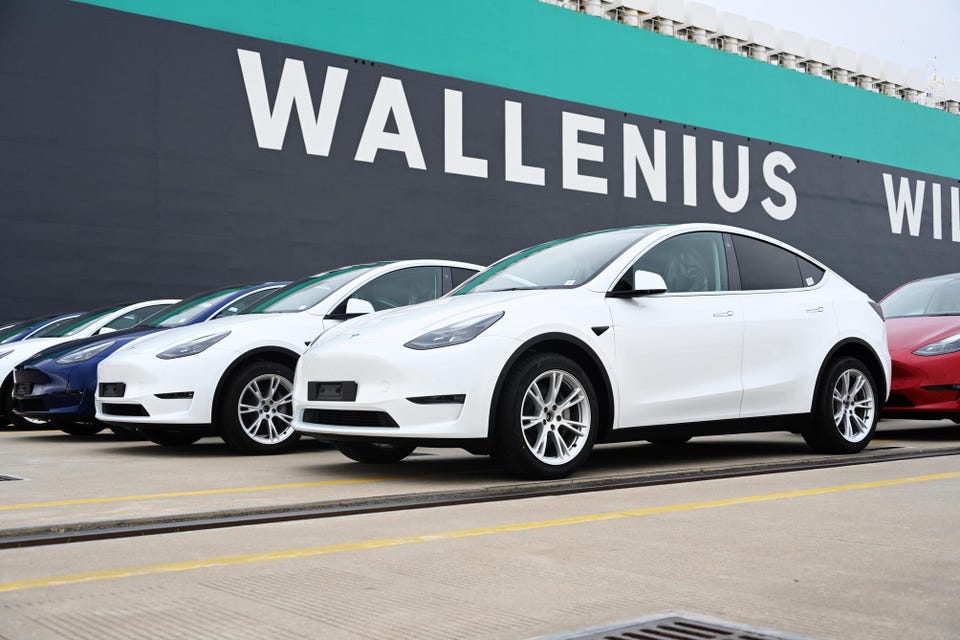The Slump In Tesla’s Share Price Does Not Reflect The Bright Future For Electric Vehicles


SHANGHAI, CHINA – MAY 15: A total of 4,027 Tesla Model Y and Model 3 electric vehicles, which will … [+] be sent to the Port of Zeebrugge in Belgium, wait to be loaded on board the roll-on-roll-off cargo vessel Theben operated by Wallenius Wilhelmsen at Nangang port on May 15, 2022 in Shanghai, China. (Photo by Shen Chunchen/VCG via Getty Images)
VCG via Getty Images
Tesla missing their ambitious production targets and lower share price say a lot about the broad challenges facing electric vehicle manufacturers. On the supply side, Tesla boss Elon Musk has bemoaned the ongoing disruption to supply chains and in particular semiconductors. The demand side is being weighed down by consumers grappling with high inflation, whilst the decision to cut prices by up to 30% for some Tesla models is a reflection increasing competition in the EV market, according to some analysts.
Tesla’s share price fell some 65% last year and whilst there are experts better placed to analyze the performance and expectations of Tesla as a company, I can provide insight into the unstoppable growth of electric vehicles.
The future undoubtedly belongs to EVs, but the transition away from internal combustion engine (ICE) vehicles is facing short term headwinds. The war in Ukraine and the COVID-19 pandemic exacerbated existing deglobalization trends. Supply chains, notably for some critical metals are experiencing increased vulnerability. However, our analysis shows that for most critical resources, such disruptions will eventually be circumvented by alternative battery chemistries, new sites of production and new materials. Yet, in the short run to 2030, supply-chain disruption effects will delay the transition. For example, according to our Energy Transition Outlook, we now expect the timing of the ‘yardstick’ measure for EV uptake – when EVs constitute 50% of new car sales – to be delayed by one year, to 2033, compared to our analysis a year ago. Still, in 10 years, we do expect half of all vehicles sales globally to be fully electric.

Despite accounting for the majority of the global road transport fleet in 2050, electric vehicles … [+] will make up a much smaller portion of energy demand compared to internal combustion engine vehicles.
DNV
The efficiency gains and lower costs associated with electric vehicles have convinced the boards of most major car manufacturers to pivot away from combustion engines and triggered the creation of numerous of start-ups. However, there is still skepticism amongst consumers. This is partly because of concerns about charging infrastructure and range anxiety. It is also because the upfront cost of EVs is generally higher. Even though EVs already have much lower running cost per 100 km, private buyers mainly look at purchase price rather than the total cost of ownership. Indeed, over the lifespan, EVs are already cheaper to own than ICE vehicles most places. However, consumer behavior often lags cost development, as the incumbent technology always feels like a safe bet.
Policy remains important to the speed of EV uptake. Norway – which has bought so many Teslas that last year Elon Musk felt compelled to travel to the country to thank its residents – has given tax breaks and preferential treatment to EVs for several years and in 2022 79% of cars sold in the country were fully electric. In neighboring Denmark, where government policy has been less encouraging, that figure was around 8%.

Energy demand from the transport sector will fall as electrification increases efficiency
DNV
By the middle of the century, even considering the dampening effect of car sharing and automation, the global passenger-vehicle fleet will increase by about 50%. That does not mean that energy demand from the road sector will increase. Actually, it is quite the opposite. Road-sector energy demand will be considerably lower in 2050 than it is today, principally because electric engines have an efficiency of about 90% and hence are three to four times more efficient than vehicles with combustion engines, whose efficiency typically is about 25-30%. While over three quarters of vehicles globally (78%) will be EVs in 2050, they will constitute only around 30% of the road subsector’s energy demand. In the same timeframe, fossil fuel oil will represent close to 60% of the global road subsector’s energy demand, despite ICE vehicles making up a much smaller proportion of the global fleet.
EVs will make up nearly 80% of the global passenger fleet in 2050. Even if countries do not replicate Norway’s progressive EV policy, the efficiency superiority will give them the market lead.
